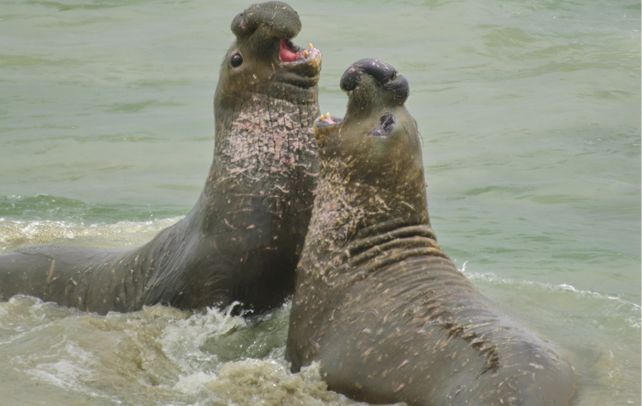Fun Facts About Elephant Seal

Elephant Seals, with trunk like snouts, derive their name from their terrestrial counterparts, the elephants. However, unlike elephants, elephant seals do not walk the earth; they slither, with the help of their fin (like that of a giant fish) and look adorable while doing so. And though they look astonishingly peaceful from outside, they are terrific fighters when it comes down to defending their territories, and females. They are gluttons, and eating is all they do when awake; well, they have to, to maintain the figure which these giants are popular for. But despite of their massive size, they are great swimmers and take deep dives in search of food when it is scarce on the surface. Found on the shores of Argentina, South Africa, Mexico, Canada and New Zealand, elephant seals are considered vulnerable, and it’s illegal to hunt them. The following section contains lots of interesting and amazing information about elephant seals, knowing which will surely make you fall in love with these gigantic creatures. Have a read now.
Fast Facts
Scientific Name: Mirounga
Kingdom: Animalia
Phylum: Chordata
Class: Mammalia
Order: Carnivora
Suborder: Pinnipedia
Family: Phocidae
Genus: Mirounga
Diet: Carnivore (fish, squid, octopus)
Average Size: 14 to 16 feet (depending on species)
Weight: 900 to 3,000 kg (depending on species; some can weigh as much as 4,000 kg
Average Age: 9 years for northern elephant seals and 20 to 22 years for southern elephant seal
Gestation Period: 11 months
Habitat: Warm coastal waters close to land
Skin Type: Fur
Average Litter Size: 1
Interesting And Fun Facts About Elephant Seal
- The elephant seals have only two species: northern elephant seal and the southern elephant seal. They derive their name from the hemisphere they are found in.
- Elephant seals are large sea creatures and when killed, suffice for food for a large family for a long time. Because of this, there was a time when elephant seals were hunted for their flesh and teeth with such fanaticism that they came to the brink of extinction and were declared a protected species during the nineteenth century.
- The elephant seals derive their name from the large proboscis or snout which resembles an elephant’s trunk. This snout like feature is a part of the anatomy of a male elephant seal only, and is used by them in making extraordinarily loud roaring noises during mating competitions.
- These animals are known for their huge bodies, which is the reason that these creatures are also called sea elephants. But, the largest elephant seal which has been recorded so far weighed 5,000 kg and measured 6.9 meters in length.
- These are basically marine mammals and spend most of their lives inside ocean water. Though they don’t have aquatic glands, but their bodies are well adapted to spend long durations inside water.
- Elephant seals are great divers and can hold their breaths for long durations. They can stay inside water for more than 100 minutes, which is a record for a non-cetacean mammal. These seals can also dive to about 1,600 meters deep in ocean water but, the record of deepest dive (2,388 m) is held by the southern elephant seals.
- Their bodies contain high volumes of blood which helps them in staying in depths of the ocean for much longer time as their blood holds much of oxygen which comes to use when they take a dive.
- These seals are carnivores and hunt for small aquatic animals such as skates, rays, octopuses, squids, penguins, eels and small sharks which become easy prey for these mammoths.
- Despite their ginormous size, elephant seals aren’t slow. In fact, they are really good swimmers and if by any chance you see this animal approaching from a distance, run for cover as they can move faster than humans on sand dunes.
- Most part of a seals’ anatomy is blubber, which is a thick coat of fat accumulated by the animals during the period they are active. This blubber saves them from extreme cold during winters.
- A female elephant seal has an average life expectancy of 23 years and it attains sexual maturity at an age of four to five years. The average life expectancy of a bull elephant seal is a little less than their female counterparts; it is twenty years.
- The concept of alpha male or beta male exists within elephant seals too. An alpha is the male which is not only the strongest one of the group but is also responsible for impregnating the females of its herd. It can go on impregnating as many as fifty females in a single season. The beta male on the other hand is its obedient subordinate.
- An alpha elephant seal will have a harem of thirty to hundred females which will solely be impregnated by it. In a lifetime, a successful seal can sire over 500 pups, whereas, lifetime reproduction potential of a female elephant seal is ten pups on an average.
- These animals cannot mate in the sea because of their weight and secondly, because of the prolonged period of mating session which makes it impossible for these giants to mate underwater. So, after coming to shore, mostly for mating, males fast for three months and the females fast for five weeks during the time they mate and nurse their pups.
- A male elephant seal has an obligation to stay in its territory, on land as well as water, to defend it from other predators and males. For this, it sometimes has to stay without food for long intervals of time, and have to procure energy from the blubber.









